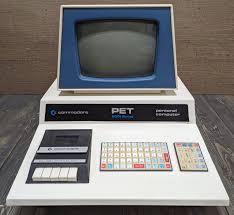
The Commodore PET: A Landmark in Computer History
In 1977, Commodore International introduced the PET (Personal Electronic Transactor), a pioneering personal computer that played a significant role in the early days of computing.
The Commodore PET featured a built-in keyboard, monitor, and cassette tape drive, making it a self-contained unit that was easy to use right out of the box. It was one of the first computers to be aimed at consumers rather than hobbyists or businesses.
With its 1 MHz processor and up to 8 KB of memory, the PET was considered powerful for its time and found popularity in schools and small businesses. Its integrated design set it apart from other computers on the market at the time.
One of the most notable features of the PET was its operating system, which included a built-in version of Microsoft BASIC. This made programming accessible to users without requiring additional software or hardware.
Despite its success, the PET faced competition from other emerging personal computers like the Apple II and TRS-80. However, its impact on the computer industry cannot be overstated, as it helped pave the way for future advancements in personal computing.
Today, the Commodore PET is remembered as a landmark in computer history and a symbol of innovation and progress in the world of technology.
5 Essential Tips for Understanding the 1977 Commodore PET
- The Commodore PET 2001 was released in 1977 as one of the earliest personal computers.
- It featured a built-in cassette tape drive for storage and a monochrome monitor.
- The PET used a full-size keyboard with calculator-style keys.
- Programming on the PET was done in BASIC, which was stored in ROM.
- The original PET models had only 4KB of memory, which could be expanded with additional RAM chips.
The Commodore PET 2001 was released in 1977 as one of the earliest personal computers.
The Commodore PET 2001, released in 1977, holds a significant place in computer history as one of the earliest personal computers to hit the market. Its integrated design, featuring a built-in keyboard, monitor, and cassette tape drive, set it apart from other computers of its time and made it accessible to consumers looking for a user-friendly computing experience. The PET 2001’s release marked a milestone in the evolution of personal computing, laying the groundwork for the future of technology and shaping the way we interact with computers today.
It featured a built-in cassette tape drive for storage and a monochrome monitor.
The 1977 Commodore PET was ahead of its time with innovative features like a built-in cassette tape drive for storage and a monochrome monitor. This integrated design made the PET a convenient and user-friendly option for early computer users, setting it apart from other systems of its era. The inclusion of these components not only streamlined the user experience but also showcased Commodore’s commitment to providing a comprehensive computing solution in a single package.
The PET used a full-size keyboard with calculator-style keys.
The 1977 Commodore PET was known for its innovative design feature of utilizing a full-size keyboard with calculator-style keys. This unique keyboard layout made typing and data entry more comfortable and efficient for users, setting the PET apart from other computers of its time. The inclusion of these familiar keys not only enhanced the user experience but also contributed to the PET’s user-friendly design, making it accessible to a wide range of individuals, from students to professionals.
Programming on the PET was done in BASIC, which was stored in ROM.
Programming on the Commodore PET in 1977 was made easy and accessible thanks to the inclusion of BASIC, which was stored in ROM. This meant that users could start coding right away without the need for external software or additional setup. BASIC’s presence in ROM ensured that it was always available and ready to use, making the process of programming on the PET straightforward and convenient for users of all levels of experience.
The original PET models had only 4KB of memory, which could be expanded with additional RAM chips.
The original PET models from 1977 were equipped with just 4KB of memory, a modest amount even by the standards of the time. However, users had the option to expand the memory capacity by adding additional RAM chips to accommodate their computing needs. This feature allowed for increased flexibility and functionality, enabling users to customize their PET computers to better suit their specific requirements.
